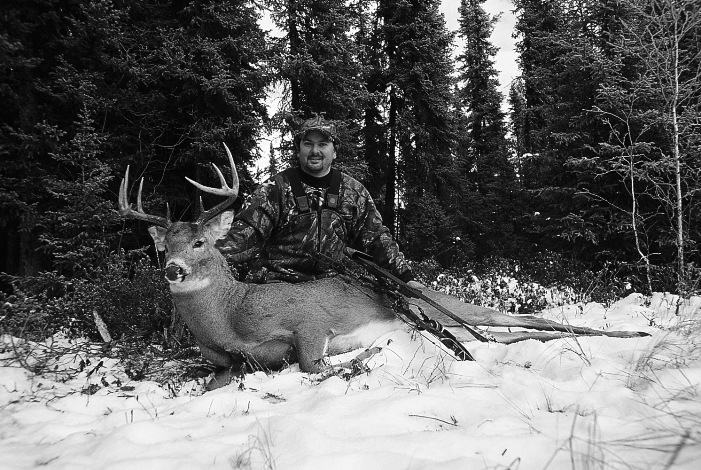Previously: Warm Shelter, Dependable Transport; Encounters, But Not Close Enough
“Jurassic” Trophy Buck
 The next morning found me set up in a ground blind near a hidden, deep-woods alfalfa field literally trampled with tracks. Earlier in the hunt, Bateman had even pointed out a large moose bed in a far corner. With rattling antlers in tow, I’d waited a full hour after first light before producing the best battling bucks symphony I knew how, then paused. It wasn’t long before twigs snapped somewhere behind me, and then, a loud snort. And then, nothing. Had I startled a buck on its way to feed in the field?
The next morning found me set up in a ground blind near a hidden, deep-woods alfalfa field literally trampled with tracks. Earlier in the hunt, Bateman had even pointed out a large moose bed in a far corner. With rattling antlers in tow, I’d waited a full hour after first light before producing the best battling bucks symphony I knew how, then paused. It wasn’t long before twigs snapped somewhere behind me, and then, a loud snort. And then, nothing. Had I startled a buck on its way to feed in the field?
An hour later I watched as a lone doe, then two yearlings fed into the field below me. They’d passed within 40 yards of my blind without alerting, so I felt confident in the makeshift spruce-bough blind. I feared it was my scent—helped along by a squirrely wind—that had foiled the earlier encounter.
By the evening of Day 3, I’d fallen into a familiar cold-weather hunting “routine” that had allowed me to gauge exactly the garments needed to spend extended periods in the frigid, though stable, Alberta conditions. My confidence got yet another boost when Bateman suggested my evening hunt unfold at “Jurassic Park”—one of the furthermost stand sites from Bateman’s base camp, but also one of the best—so named for the gargantuan bucks taken there in the past. My arm didn’t need twisting.
Soon I was setting my climbing stand in a thick spruce forest that rimmed a remote creek bed—the heart of Jurassic Park country. Perched on the edge of a wide, abandoned logging trail, I could shoot more than 20 yards to the front of me, and well past my effective range to each side. Better yet, I’d be able to see deer crossing the trail for literally hundreds of yards.
The Argo’s whining drone was a distant memory when the first deer of the night finally showed. With maybe 20 minutes of shooting light remaining, the deer approached head-on, angling toward a trail I could shoot sitting down. Since I was caught sitting there I remained, until the deer—which I could now see was a good buck—hung a left, to my right, and paralleled the tall spruce corridor. I was caught and I knew it; I couldn’t shoot to my right unless I stood, and so I automatically began inching up.
The buck busted me in the first two inches. He didn’t see me, mind you, but he heard me, and tensed even at the ultra-soft swish of fleece on tree bark. One more step by the deer and two more inches I slid up; the buck heard it again and paused. Now caught in an awkward crouch I knew I had to go for it. Straightening to full height, I had just enough time to come to full draw as the buck turned to leave—and lingered there just a little too long.
I can still see the arrow’s laser-straight flight, disappearing to my eye somewhere near the medium-brown coat. One bound, then a quick sprint, and the Alberta 10-point stiffened, then staggered and fell. He’d barely covered 25 yards.
As I knelt beside the fallen buck and brushed the snow from the shining rack and thick coat, I wondered just how any creature could survive a long winter in this wild and frozen place. I was also enlightened; I knew then, unequivocally, why bowhunters cloak themselves in bulky extreme weather gear and travel regularly, each November, to frigid Alberta: The answer was right there in my hands.






